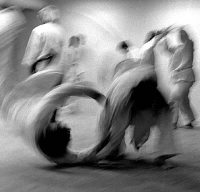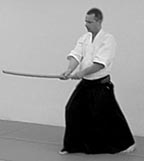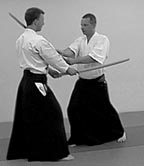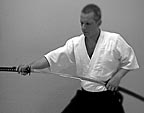
This is how it started:
As a member of the Swedish aikido dan grading committee, I was looking at some of my own students examined - and I had to admit that when it got to their performance with the bokken and jo, they did not all of them do as well as could be expected. In our dojo we do a decent amount of training with those tools, and I would like to think that the instruction is not completely off the track. My students should, I had thought, handle it well also in a dan grading.
But I found that they made their series of movements with some awkwardness, almost in a mood of alienation. They could grip their tools acceptably, and swing them too - but in the combination of movements there was a lot of hesitation, making it all less convincing.
Immediately I understood that they were not to blame, but I was. They were just expressing the backside of a teaching method I had been using for the last several years - one of improvisation, of always making up new combinations in class, not sticking to any system of exercises at all. Inventing kata as we went along.
Improvised budo

In aikido one would say it was in a spirit of takemusu, improvised
budo, born in the moment. That is, I still believe, a mighty essence in
any Martial Art - well, in any art.
I had hoped that my students would learn, by this, not only the applied
basics of how to use the sword and the jo, but also make their minds free
enough to choose techniques according to circumstance - instead of sort
of freezing, when things didn't go exactly "according to plan". I wanted
to teach them creativity, an open mind, and the ability that goes
with it.
Instead, some of them - well, most of them - had gotten uncertain about
how to move from one position to the next, what action with which to meet
the opponent's initiative, etcetera. They lacked a firm understanding of
how to apply their basic sword movements. Their improvisation became a
mostly random combination of techniques, sometimes in their right and
functional places, sometimes not. More often than not they got completely
lost in it.
It was clear that I had to rethink my teaching method.
From suburi to complexity
Myself, I have gone through a spectrum of teaching methods, through the years. When I started in the early 70's, we had lots of hours with Ichimura sensei - aikido shihan of Sweden at the time, and distinguished in both aikido and iaido - where we were standing in a circle doing more chudan giri than anyone could possibly enjoy. There was more to his teaching, of course, but the suburi, the repetitive exercising of basic movements, was always near at hand.
And some ten years later we were introduced to Shoji Nishio sensei, although originally Ichimura's teacher a very different cup of tea. His movements were so complex and refined, it took us years - literally - just to perceive how he was moving. Not to mention how long it took to copy these moves, even in a very unpolished, not to say clumsy way.
When struggling to learn Nishio sensei's way of using the sword and the jo, I was grateful to have been forced to such a lot of suburi, long before, not having to think of that as well - it would have been too much.
I could see, though, that students who had not gone through a sufficient
amount of basic training before trying to learn Nishio sensei's system,
they had little chance of getting their basics right along the way. Quite
the contrary - the many difficult and tricky moves seemed to seduce the
students into ignoring the importance of basics - such as gripping, cutting,
balance, center and force.

Anyone properly introduced into the sword arts would immediately say
that without such basics, there is not much of a sword art remaining.
Actually, Nishio sensei also pointed this out, when on a seminar he suddenly halted the training of his complicated kata to do some regular down to earth suburi. We did that basic training for a while, straightforward cutting exercises pretty much like in a normal kendo class, and then he explained to the congregation that this type of training must also be done. It was for the local instructors to take care of, on a regular basis, so that when he came for a seminar, everyone could concentrate on what was more relevant for him to teach - that is, the stuff even the local instructors were not properly competent with.
Breaking up in parts
Thinking about this, I decided not to teach my students the full and exact system of Nishio sensei's ken and jo, but to break the kata up in small parts, do them in that small parts or mix them in different ways - to make my students focus on polishing the parts instead of trying to rush through the complete combinations in a speed similar to that of Nishio sensei.
It worked rather well, I felt, especially in preparing the students for the Nishio sensei seminars - we had him visiting our dojo several times during the 90's. I could see that my students managed to perform the kata he showed us, although they had not learned the combinations by heart - but they were familiar with the parts.
So I still believe this is a good way of introducing students to and preparing them for Nishio sensei's system, if that is the goal.
On the other hand, this system of no-system made my students lacking in ability to combine the parts convincingly - and I realized that they were not enough familiarized with a way of doing so. Watching their efforts at that dan grading, I had to admit that some kind of system of training was needed.
Few movements, but all of them
Still, there was one thing to avoid: too complex a system takes the student's mind off the basics, and a competent handling of the sword risks to be substituted with a vast number of kata, all of them poorly performed.
So a system of basic sword training had to be simple - much like Seitei Iai of the ZNKR: a limited number of forms, with a very limited number of movements in each. Actually, pretty much like suburi in disguise. A way for the students to practice the basic movements repeatedly, without being too bored by it.
Yet, the system would have little meaning if it were not to include all of the important movements, and most of the others as well - at least the ones not regarded as odd or exotic in Japanese sword schools. It would be good, too, if a substantial part of sword art terminology were used, so that it would be memorized and understood in its context.
Furthermore, being primarily aimed at aikido students, such a sword
exercise system would need to fit reasonably well with aikido strategy,
movements and principles. For example, in many sword art techniques, the
evasive step usually called taisabaki in aikido, is often absent - instead
it is often a head-on movement of the body. Not so, in for example, Nishio
sensei's system, of course, but certainly in Seitei of ZNKR. If not, the
latter would probably do fine as a system of basic sword exercises.

But there is one more ingredient needed for the aikidoka - the partner
training, the fencing if you will. Seitei Iai could probably be trained
in such a way, if some creative thinking were applied to it, but not ideally
- especially not for aikidoka.
I needed a basic system, then, possible to train - without changing its forms - solo in iaido fashion, or with partner.
That was to be Aiki Batto, to which I would like to return in detail, in my next article.